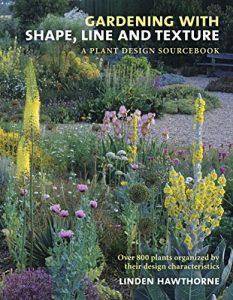The “New Look” Landscape
By George Graine, Fairfax Master Gardener
“Style is a matter of taste; design is a matter of principles.”
–Thomas Church in “Gardens Are For People” (1955)
 In the world of garden books, one that is nearly a decade old can probably be found on a book store remainder pile, at a used book store or a library book sale. Often this can be a great find, and you could say “good for me,” and save more than a few bucks. Such was the case with “Gardening with Shape, Line and Texture” by Landscape Designer Linden Hawthorne (Timber Press, 2009). The attributes of plants and more are included in plant descriptions with many color photos. Take note that when reading books that emphasize landscape design, you may wonder if you will come away with the feeling that something is missing. Perhaps it could be the lack of more detailed information and/or insufficient illustrations. Almost ten years ago, Linden Hawthorne took a decidedly different approach to the design process. Her emphasis, as you can tell from the book title, is concerned with plant shape and other plant properties. Do not be alarmed if color is not front and center because if you think about it, color is a fleeting attribute.
In the world of garden books, one that is nearly a decade old can probably be found on a book store remainder pile, at a used book store or a library book sale. Often this can be a great find, and you could say “good for me,” and save more than a few bucks. Such was the case with “Gardening with Shape, Line and Texture” by Landscape Designer Linden Hawthorne (Timber Press, 2009). The attributes of plants and more are included in plant descriptions with many color photos. Take note that when reading books that emphasize landscape design, you may wonder if you will come away with the feeling that something is missing. Perhaps it could be the lack of more detailed information and/or insufficient illustrations. Almost ten years ago, Linden Hawthorne took a decidedly different approach to the design process. Her emphasis, as you can tell from the book title, is concerned with plant shape and other plant properties. Do not be alarmed if color is not front and center because if you think about it, color is a fleeting attribute.
If the horticultural trade publications are to be believed, they tend to emphasize a different view. In fact, they indicate that color is the first element in design DNA. On the flip side, one should be cautious with color as the number one aspect in landscape design, and Hawthorne points this out with easy-to-understand explanations.
Recently, modern landscapes have shrunk; therefore, the available area for planting is also limited. In observing many newer community developments, you will see an inverse proportion with larger houses on smaller lots. If these types of properties are going to become the new landscapes for many homeowners, then perhaps it is time to consider digital technology to help you contemplate and design a landscape. Actually, the internet is a wonderful source for many of us. Exploring technology can help to determine a design and alternatives to a landscape that fit both your personality and landscape dimensions. In this regard, as previously noted, color does take a back seat to plant shape, line and texture.
The first chapter of the book refers to “Painting with Plants,” and it is the key to understanding the entire text. It shows how plant compositions ought to relate to each other and how plant shapes contribute to the success of good landscape design. Within the first 30 pages you will realize why the subtitle of the book, “A Plant Design Sourcebook,” is paramount to many categories that contribute to plant shapes. Also, you will read why Hawthorne considers shape as primary, and her appreciation for an entire plant becomes obvious. The follow-on chapters are written so that almost any type of plant will fit into five categories. These titles may be a tad obscure; however, they do make a lot of sense as you follow the mind of an extraordinary landscape designer. Each chapter begins with important explanatory remarks, and the plants in each chapter are in alphabetical order starting with botanical Latin names and followed by the plants’ common names. The plant-type chapters include (1) Horizontals and Tiers, (2) Verticals and Diagonals, (3) Arcs and Fountains (cascading not water), (4) Clumps and Mounds and (5) Clouds and Transparents (decorative and finishing touches). Of course, you can gloss over some chapters, and some will be spot-on for whatever you are attempting to accomplish in your landscape. What style fits you? The design community employs simple shorthand to describe design as formal, semi-formal, informal and wild. The latter is open to several interpretations. Think meadow and let’s leave it at that. Within any of these categories there can be many variations. To indicate several, there could be variety and contrast, rhythm and repetition, balance, focal points and even surprise.
In summary, “Gardening with Shape, Line and Texture” will improve your own landscape design. Grouping plants will show an increased impact as you realize the whole plant and not just the color. By the way, the writer Kevin Doyle noted that texture and foliage keep a garden interesting through the season. Flowers are just moments of gratification.